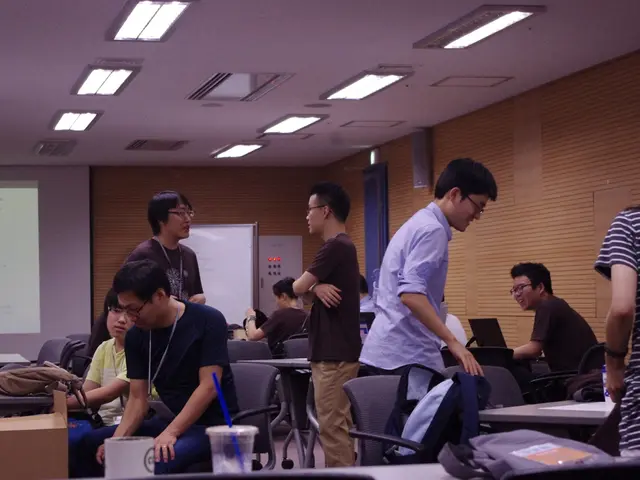Unveiling the Japanese Business Mentality: Insights into Kaizen
Kaizen: A Japanese Business Philosophy for Continuous Improvement
Kaizen is a multifaceted Japanese business philosophy that focuses on making incremental changes to enhance efficiency, quality, and eliminate waste within an organization. Originating in Japan, it has become a globally recognized method for driving ongoing improvement in various sectors.
Key components of the kaizen concept include fostering a team-oriented environment, improving processes and procedures, promoting employee engagement, and making jobs more fulfilling, less strenuous, and safer. Companies worldwide are now embracing this philosophy in different formats.
Key Takeaways
- Kaizen is a Japanese business strategy aimed at improving work efficiency, quality, and reducing waste.
- The philosophy has gained worldwide popularity and is now implemented across various industries.
- Its underpinnings include teamwork, process improvement, employee engagement, and continuous innovation.
Understanding Kaizen Philosophy
The ultimate goal of kaizen is to implement continuous, small-scale improvements within a company to achieve long-term benefits such as better quality control, more efficient processes, and waste elimination. These gains can lead to a host of advantages, including improved resource management, enhanced safety, lower costs, and increased customer satisfaction.
Empowering employees to participate in the kaizen process is crucial. Every team member can identify potential areas for improvement and propose viable solutions, fostering a sense of shared responsibility and ownership in the company's success.
Toyota, one of the most well-known champions of kaizen, employs this philosophy as a cornerstone of its values.The company encourages and empowers its employees to proactively identify potential improvements and create effective solutions. Their process for identifying solutions is called "kaizen blitz."
Kaizen Principles
Kaizen is often distilled into a defined set of principles. For instance, the Kaizen Institute, founded by Masaaki Imai and author of the influential 1986 book on the topic, emphasizes the following points:
- Understand your customers' needs.
- Eliminate waste in the workflow.
- Focus on the actual work site (gemba).
- Empower your employees.
- Be transparent.
The essence of kaizen lies in recognizing that the individuals performing tasks have the most relevant knowledge about them. By empowering those individuals to affect change, organizations can achieve more meaningful improvements. The ideal is for kaizen to become deeply ingrained in a company's culture, driving a constant evolution and innovation mindset.
Teamwork is the backbone of kaizen, as regular meetings facilitate discussions about potential improvements and encourage brainstorming sessions to solve problems.
Benefits of Kaizen
Adopting kaizen can offer numerous advantages to organizations, including:
- Increased productivity.
- Reduced waste.
- Better resource management.
- Improved quality.
- Better safety measures.
- Lower costs.
- Higher customer satisfaction.
- Improved cooperation and communication.
- Increased employee satisfaction and morale.
The PDCA Cycle and Kaizen Improvement Process
The improvement process in kaizen often follows the PDCA (Plan-Do-Check-Act) cycle, a format first introduced in the U.S. in the 1920s. The Plan phase involves outlining changes and making sure everyone understands them before teams attempt to solve a problem.
The Do stage calls for implementing the proposed solutions. The Check step entails evaluating the effectiveness of the solution to determine whether it adequately addresses the issue. Meanwhile, when a company Acts, it decides whether the solution should become a company-wide policy or if further improvements are required. This process continues until the company achieves its desired results or deems additional changes unnecessary.
Just-in-Time Inventory Strategy
Reducing waste and increasing efficiency in the production cycle is one of the key goals of kaizen. Implementing a Just-in-Time (JIT) inventory strategy helps achieve this goal by synchronizing suppliers' raw material deliveries with production schedules, thereby minimizing excess inventory.
JIT is an integral part of the Toyota Production System, which many companies have since adopted. This strategy helps manufacturers save costs by reducing inventory carrying costs and eliminating waste due to canceled or postponed orders.
The Kanban system, another Japanese innovation, supports JIT inventory strategies. Kanban is an inventory control system that enables employees to quickly order parts and materials as they are needed, ensuring an efficient factory assembly line and preventing bottlenecks.
In Conclusion
Kaizen is both a philosophy and a practical system that promotes continuous improvement in organizations. Originating from Japan, it has expanded globally, making a significant impact on various industries by improving efficiency, reducing waste, and increasing profitability. Through teamwork, empowerment, and a focus on employee engagement, companies can maximize their potential for success and achieve long-term, sustainable growth.
- In the realm of finance, Kaizen's principles can aid in the optimization of business processes, leading to increased efficiency and reduced waste.
- As technology continues to evolve, integrating Kaizen's continuous improvement philosophy could potentially revolutionize manufacturing processes, streamlining production and boosting productivity.
- In the education-and-self-development sector, the Kaizen mindset can foster personal-growth by encouraging individuals to consistently seek small-scale improvements in their skills and knowledge, ultimately leading to long-term benefits.
- Initial Coin Offerings (ICO) in the digital finance industry may benefit from adopting a Kaizen approach to ensure continuous innovation, improve product quality, and reduce waste, such as the inefficiencies arising from intermediaries in traditional finance.







